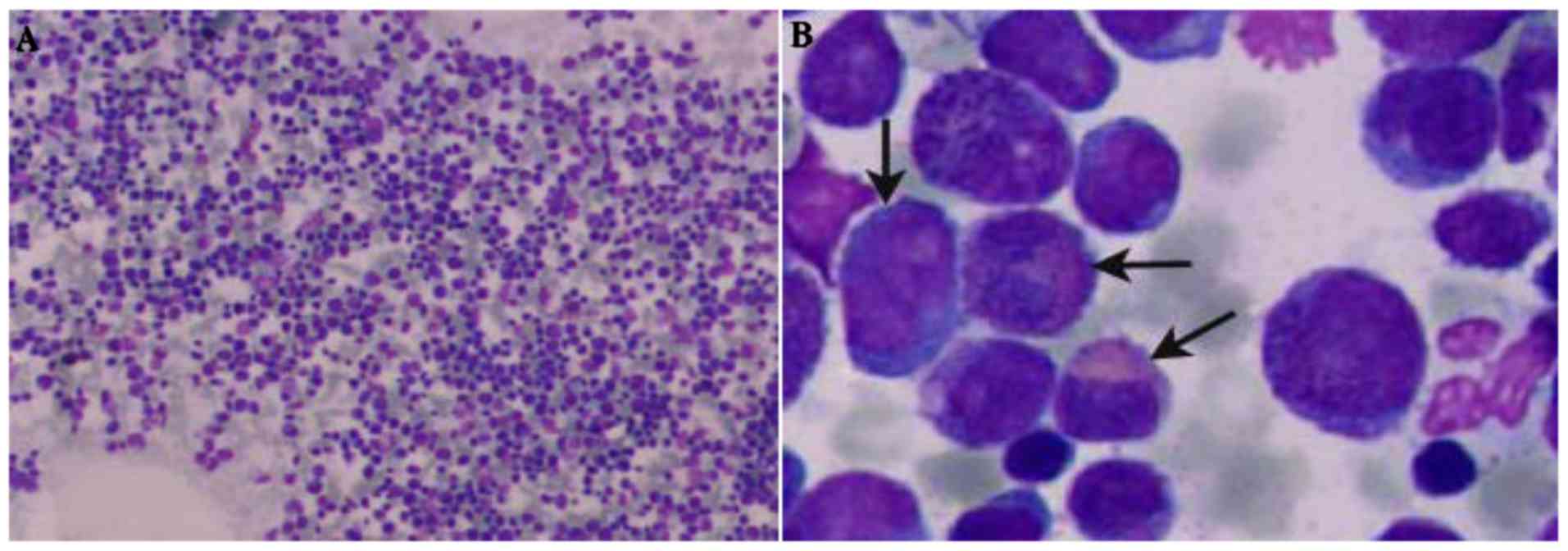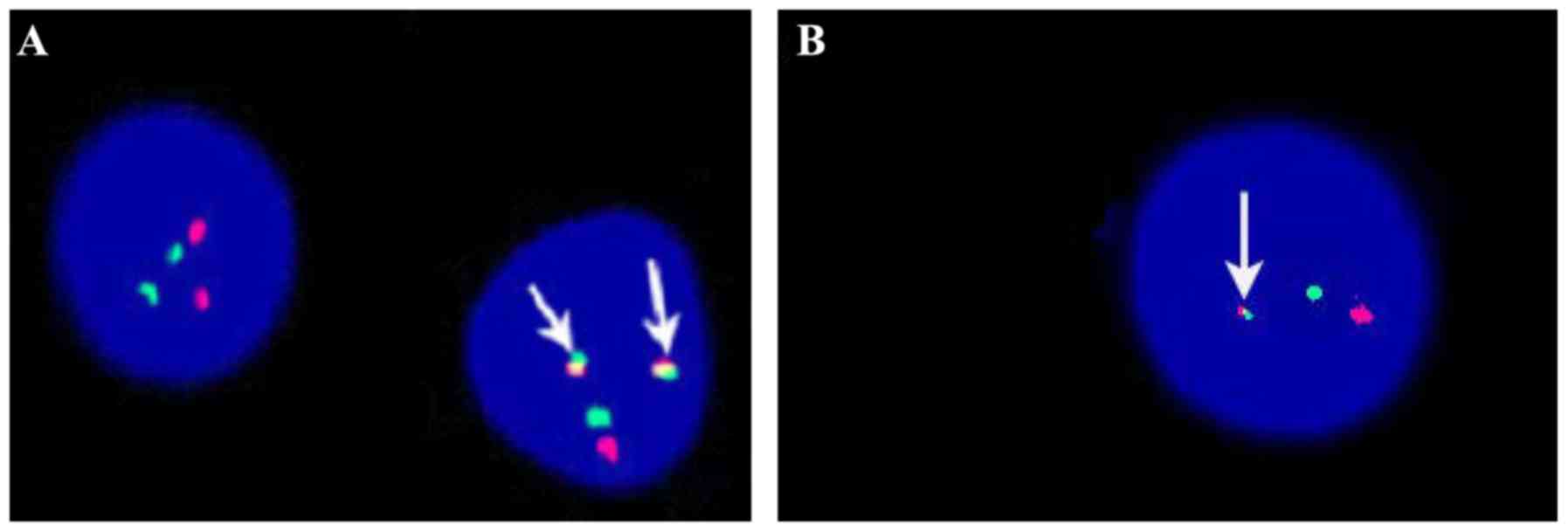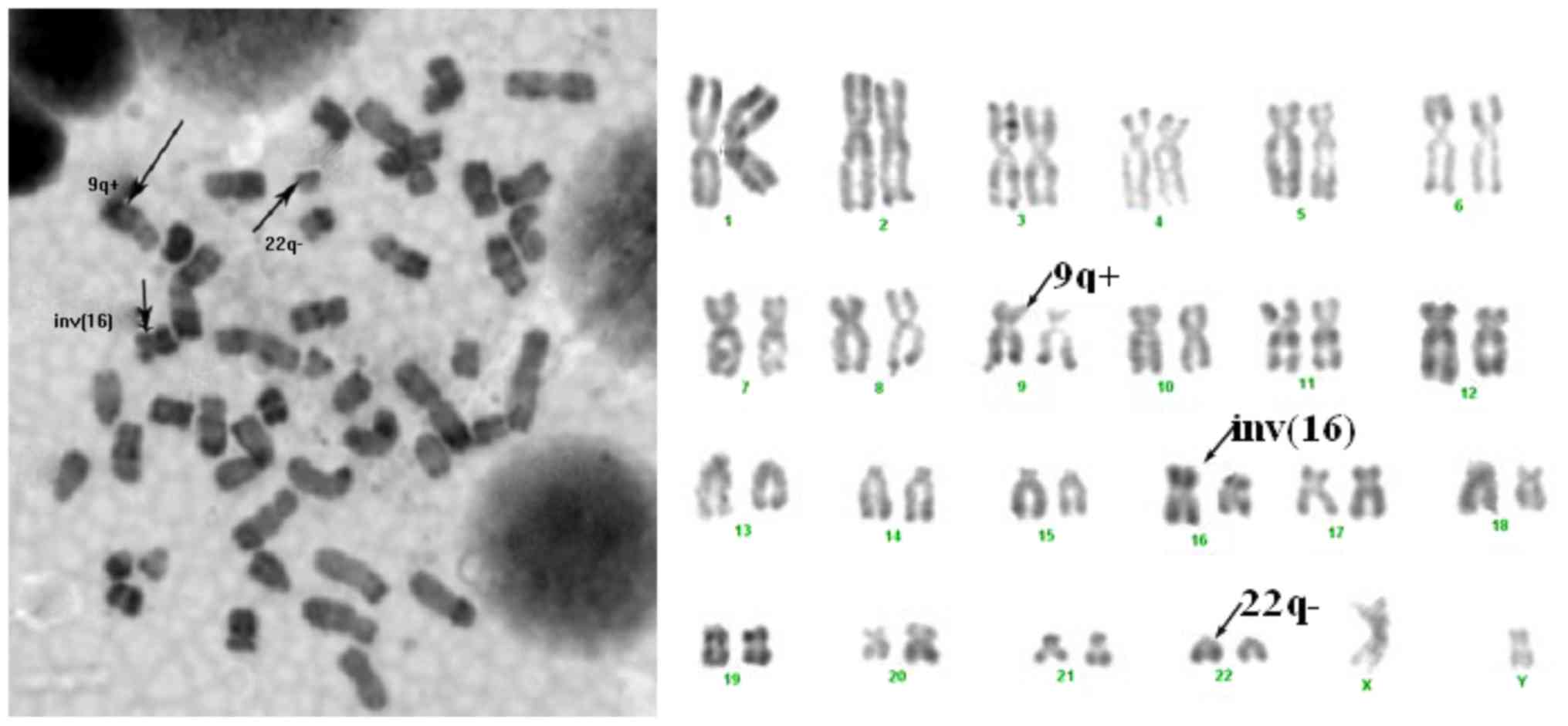|
1
|
Cividin M, Brizard F, Sorel N, Renaud M,
Guilhot F and Brizard A: p190(BCR-ABL) rearrangement as a secondary
change in a case of acutenmyelo-monocytic leukemia with
inv(16)(p13q22). Leuk Res. 28:97–99. 2004. View Article : Google Scholar : PubMed/NCBI
|
|
2
|
Delaunay J, Vey N, Leblanc T, Fenaux P,
Rigal-Huguet F, Witz F, Lamy T, Auvrignon A, Blaise D, Pigneux A,
et al: Prognosis of inv(16)/t(16;16) acute myeloid leukemia (AML):
a survey of 110 cases from the French AML Intergroup. Blood.
102:462–469. 2003. View Article : Google Scholar : PubMed/NCBI
|
|
3
|
Liu P, Tarlé SA, Hajra A, Claxton DF,
Marlton P, Freedman M, Siciliano MJ and Collins FS: Fusion between
transcription factor CBF beta/PEBP2 beta and a myosin heavy chain
in acute myeloid leukemia. Science. 261:1041–1044. 1993. View Article : Google Scholar : PubMed/NCBI
|
|
4
|
Kundu M and Liu PP: Function of the
inv(16) fusion gene CBFB-MYH11. Current Opinion in Hematology.
8:2012001. View Article : Google Scholar : PubMed/NCBI
|
|
5
|
Swerdlow S, Campo E, Harris NL, Jaffe ES,
Pileri SA, Stein H, Thiele J and Vardiman JW: WHO classification of
tumors of hematopoietic and lymphoid tissues. 4th. IARC WHO
Classification of Tumours; Lyon: 2008
|
|
6
|
Nowell PC and Hungerford DA: A minute
chromosome in human chronic granulocytic leukemia. Science.
142:14971960.
|
|
7
|
Rowley JD: Letter: a new consistent
chromosomal abnormality in chronic myelogenous leukemia identified
by quinacrine fluorescence and Giemsa staining. Nature.
243:290–293. 1973. View
Article : Google Scholar : PubMed/NCBI
|
|
8
|
Faderl S, Talpaz M, Kantarjian HM and
Estrov Z: Should polymerase chain reaction analysis to detect
minimal residual disease in patients with chronic myelogenous
leukemia be used in clinical decision making? Blood. 93:2755–2759.
1999.PubMed/NCBI
|
|
9
|
World Health Organization Classification
of Tumours: Pathology and genetics of tumours of haematopoietic and
lymphoid tissues. Jaffe ES, Harris NL, Stein H and Vardiman JW:
IARC WHO Classification of Tumours; Lyon: pp. 3522001
|
|
10
|
Keung YK, Beaty M, Powell BL, Molnar I,
Buss D and Pettenati M: Philadelphia chromosome positive
myelodysplastic syndrome and acute myeloid leukemia-retrospective
study and review of literature. Leuk Res. 28:579–586. 2004.
View Article : Google Scholar : PubMed/NCBI
|
|
11
|
Livak KJ and Schmittgen TD: Analysis of
relative gene expression data using real-time quantitative PCR and
the 2(-Delta Delta C(T)) method. Methods. 25:402–408. 2001.
View Article : Google Scholar : PubMed/NCBI
|
|
12
|
Cheung SW, Crane JP and Burgess AC: High
resolution R banding in amniotic fluid cells using the BrdU-Hoechst
33258-Giemsa (RBG) technique. Human Genetics. 69:86–87. 1985.
View Article : Google Scholar : PubMed/NCBI
|
|
13
|
Shaffer LG, Slovak ML and Campbell LJ:
International Standing Committee on Human Cytogenetic Nomenclature:
ISCN 2009: An international system for human cytogenetic
nomenclature. Shaffer LG, Slovak ML and Campbell LJ: Karger
Publishers; Switzerland: 2009
|
|
14
|
Li X, Li X, Xie W, Hu Y, Li J, Du W, Liu
W, Li H, Chen X, Zhang L, et al: Comprehensive profile of
cytogenetics in 2308 Chinese children and adults with de novo acute
myeloid leukemia. Blood Cells Mol Dis. 49:107–113. 2012. View Article : Google Scholar : PubMed/NCBI
|
|
15
|
Popescu R, Dăscălescu A, Dănăilă C,
Ghiorghiu D, Zlei M, Ivanov A, Sireteanu A, Gorduza EV and Azoicăi
D: Co-expression of the CBFβ-MYH11 and BCR-ABL fusion genes in
chronic myeloid leukaemia. Revista Romana De Medicina De Laborator.
23:221–230. 2015. View Article : Google Scholar
|
|
16
|
Wu Y, Slovak ML, Snyder DS and Arber DA:
Coexistence of inversion 16 and the philadelphia chromosome in
acute and chronic myeloid leukemias: Report of six cases and review
of literature. Am J ClinPathol. 125:260–266. 2006.
|
|
17
|
Ninomiya S, Kanemura N, Tsurumi H,
Kasahara S, Hara T, Yamada T and Moriwaki H: Coexistence of
inversion 16 and the Philadelphia chromosome comprising P190
BCR/ABL in chronic myeloid leukemia blast crisis. Int J Hematol.
93:806–810. 2011. View Article : Google Scholar : PubMed/NCBI
|
|
18
|
Preudhomme C, Lai JL, Plantier I, Demory
JL, Zandecki M and Fenaux P: Cytogenetic and molecular remission in
a case of acute myeloid leukemia (AML) with inversion of chromosome
16 (inv(16)) and Philadelphia chromosome (Ph). Br J Haematol.
82:623–626. 1992. View Article : Google Scholar : PubMed/NCBI
|
|
19
|
Siddiqui AD, Sheikh ZS, Liu D and Seiter
K: Coexistence of inversion 16 and the Philadelphia chromosome in
patients with acute myelogenous leukemia. Leuk Lymphoma.
43:1137–1140. 2002. View Article : Google Scholar : PubMed/NCBI
|
|
20
|
Li YS and Hayhoe FG: Ph1 chromosome
positive acute myelomonocytic leukemia with inverted chromosome 16.
Br J Haematol. 69:5761988. View Article : Google Scholar : PubMed/NCBI
|
|
21
|
Miura I, Takatsu H, Yamaguchi A, Hashimoto
K, Nimura T, Nishinari T, Niitsu H and Miura AB: Standard Ph
chromosome t(9;22)(q34;q11), as an additional change in a patient
with acute myelomonocytic leukemia (M4Eo) associated with
inv(16)(p13q22). AM J Haematol. 45:94–96. 1994. View Article : Google Scholar
|
|
22
|
Secker-Walker LM, Morgan GJ, Min T,
Swansbury GJ, Craig J, Yamada T, Desalvo L, Medina JW, Chowdhury V,
Donahue RP, et al: Inversion of chromosome 16 with the Philadelphia
chromosome in acute myelomonocytic leukemia with eosinophilia:
report of two cases. Cancer Genet Cytogenet. 58:29–34. 1992.
View Article : Google Scholar : PubMed/NCBI
|
|
23
|
Svaldi M, Lanthaler A, Venturi R, Coser P
and Mitterer M: Simultaneous occurrence of bcr-abl and inv16 in a
case of M1 acute myeloid leukemia. Leukemia. 15:695–699. 2001.
View Article : Google Scholar : PubMed/NCBI
|
|
24
|
Tirado CA, Valdez F, Klesse L, Karandikar
NJ, Uddin N, Arbini A, Fustino N, Collins R, Patel S, Smart RL, et
al: Acute myeloid leukemia with inv(16) with CBFBMYH11, 3′CBFB
deletion, variant t(9;22) with BCR-ABL1 and del(7)(q22q32) in a
pediatric patient: case report and literature review. Cancer Genet
Cytogenet. 200:54–59. 2010. View Article : Google Scholar : PubMed/NCBI
|
|
25
|
Roth CG, Contis L, Gupta S, Agha M and
Safyan E: De novo acute myeloid leukemia with Philadelphia
chromosome (BCR-ABL)and inversion 16(CBFβ-MYH11): report of two
cases and review of the literature. Leukemia & Lymphoma.
52:531–535. 2011. View Article : Google Scholar : PubMed/NCBI
|
|
26
|
Bustamante D, Chan KR, Czuchlewski DR and
Saadi AA: Patterns of BCR breakpoints in patients with coexisting
inv(16)(p13.1q22) and t(9;22)(q34;q11.2). Int J Hematol.
95:324–326. 2012. View Article : Google Scholar : PubMed/NCBI
|
|
27
|
Merzianu M, Medeiros LJ, Cortes J, Yin C,
Lin P, Jones D, Glassman A, Kantarjian H and Huh Y: inv(16)(p13q22)
in Chronic myelogenous leukemia in blast phase: A
clinicopathologic, cytogenetic and molecular study of five cases.
Am J Clin Pathol. 124:807–814. 2005. View Article : Google Scholar : PubMed/NCBI
|
|
28
|
Tsuboi K, Komatsu H, Miwa H, Iida S, Banno
S, Wakita A, Nitta M and Ueda R: Lymphoid blastic crisis of chronic
myelogenous leukemia with inv(16)(p13;q22). Leuk Res. 26:771–774.
2002. View Article : Google Scholar : PubMed/NCBI
|
|
29
|
Myint H, Ross FM, Hall JL and Hamblin TJ:
Early transformation to acute myeloblastic leukemia with the
acquisition of inv(16) in Ph positive chronic granulocytic
leukemia. Leuk Res. 21:473–474. 1997. View Article : Google Scholar : PubMed/NCBI
|
|
30
|
Evers JP, Bagg A, Himoe E, Zwiebel JA and
Jacobson RJ: Temporal association of marrow eosinophilia with
inversion of chromosome 16 in recurrent blast crises of chronic
myelogenous leukemia. Cancer Genet Cytogenet. 62:134–139. 1992.
View Article : Google Scholar : PubMed/NCBI
|
|
31
|
Asou N, Sanada I, Tanaka K, Hidaka M,
Suzushima H, Matsuzaki H, Kawano F and Takatsuki K: Inversion of
chromosome 16 and bone marrow eosinophilia in a myelomonocytic
transformation of chronic myeloid leukemia. Cancer Genet Cytogenet.
61:197–200. 1992. View Article : Google Scholar : PubMed/NCBI
|
|
32
|
Enright H, Weisdorf D, Peterson L, Rydell
RE, Kaplan ME and Arthur DC: Inversion of chromosome 16 and
dysplastic eosinophils in accelerated phase of chronic myeloid
leukemia. Leukemia. 6:381–384. 1992.PubMed/NCBI
|
|
33
|
Heim S, Christensen BE, Fioretos T,
Sørensen AG and Pedersen NT: Acute myelomonocytic leukemia with
inv(16)(p13q22) complicating Philadelphia chromosome positive
chronic myeloid leukemia. Cancer Genet Cytogenet. 59:35–38. 1992.
View Article : Google Scholar : PubMed/NCBI
|
|
34
|
Colovic M, Jankovic G, Bila J, Djordjevic
V and Wiernik PH: Inversion of chromosome 16 in accelerated phase
of chronic myeloid leukemia: report of a case and review of the
literature. Med Oncol. 15:199–201. 1998. View Article : Google Scholar : PubMed/NCBI
|
|
35
|
Yin CC, Jones D, Cortes JE, Kantarjian H
and Merzianu M: Medeiros LJ and Bueso-Ramos CE: Type B core binding
factor β/smooth muscle myosin heavy chain fusion transcript in
myeloid blast phase of chronic myeloid leukemia: Correlation with
nuclear and cytoplasmic localization of the fusion protein.
Clinical Leukemia. 2:257–260. 2008. View Article : Google Scholar
|
|
36
|
Dai HP, Xue YQ, Wu LL, Pan JL, Gong YL, Wu
YF, Zhang J, Wu DP and Chen SN: p210BCR-ABLas a secondary change in
a patient with acute myelomonocytic leukemia(M4Eo) with inv(16).
Int J Hematol. 96:814–817. 2012. View Article : Google Scholar : PubMed/NCBI
|

















